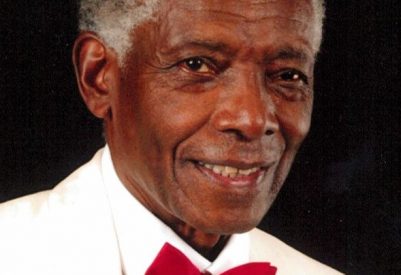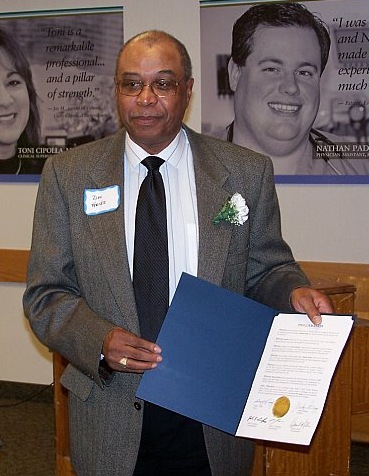
Southwest Tribune
In Dr. Young's biography entitled Tearing Down Fences: The Life of Alice Holloway Young, its author Sally Parker did a masterful job charting the pioneer’s life. Parker's approach completely justifies the book’s title.
Born into an era (Jim Crow era) when segregation by race was legal, the precocious farm girl from North Carolina, heart and soul was set on breaking down racially unjust social barriers.
In Young’s biography, Sally Parker wrote, “From her first day as a substitute teacher in 1952 to her years presiding over the board of trustees of Monroe Community College, Young was in the middle of it all. She was a tutor, teacher, principal, administrator, schools’ integrator, community college leader. But Young is more-she is a first. She was one of the first five African American teachers in the Rochester City School District, itself a first in integration efforts. She was the district’s first African American vice principal and principal. She wrote Rochester’s Title 1 programs to integrate the schools ahead of federal mandates. And in 1961, she became the only woman and the only African American on the founding board of trustees of Monroe Community College. Over and over, Young has stepped up to tear down fences in education, bringing opportunities for a good life within reach for generations of under-served students."
Young's mother, Lucy Hughes Allen, was a 1906 graduate of Hampton Institute, which was highly unlikely at that dawn of time. Unfortunately, her father John Amos Holloway did not attend school.
“My father, well, there were no schools for him, none,” she's quoted as saying in the biography. “But I’ve said over and over he was one of the most brilliant men I have ever known, really.”
During the Jim Crow era there was no high school for African Americans in Virginia where the Holloways lived at the time, so they sold their farm and moved eight miles over the border into North Carolina to be near Warren County Training School.
“Young, who started the parent-teacher association at the school, stayed involved in education,” Parker noted. “Children of friends and family in Virginia came and stayed with the nine Holloways during the week to attend school. There were no African American schools in their corner of Virginia.”
Young outperformed her classmates to become Warren County Training School’s Class of 1940 Valedictorian and landed a scholarship to attend Bennett, an all-women’s college since 1926.
She was fifteen years old, when she went off to college
“The summer after she graduated, she worked at the migrant camp in Poolville,” Parker wrote. “Not yet twenty, a product of the South herself, Young knew what it meant to live on very little. But what the migrant works were experiencing was much more than that. They weren’t free. They were stuck in a relentless cycle. When they came to her to learn how to write their names, she felt their determination to find a way out so their children could have a better life. For the first time Young could see how learning to read and write was absolutely essential for lifting out of that cycle, and she decided to become a teacher. She joined a friend who was heading to Rochester, New York, where she embarked on a career that would change everything.”
The biography depicts the social climate when Young moved to Rochester, New York as the city was entering a time of reckoning along racial lines. It noted that segregated housing practices kept African Americans and many immigrants out of white neighborhoods.
After meeting her to be husband James ‘Buddy’ Young at a reception at St. Simon’s Episcopal Church, the two were married on August 11, 1946. Their first child Rodney was born in 1947, and their second Calvin in 1949. Her stepson Jimmy was conceived during John’s first marriage. His mom unexpectedly passed away at a young age.
Young began teaching at School No. 9 becoming the third African American teacher in the Rochester City School District. Three years into teaching she had her daughter Kathleen.
Principal McNeil had told her after her first year at School No. 9: “Mrs. Young, you get as many degrees as you can under your belt. Someday the Rochester City School District will be looking for qualified Negro administrators. I don’t want them to say they can’t find one,” Parker wrote.
Noticing the fast and consistent progress of Young’s students, district officials requested that she become vice principal at Seward Elementary School No. 19, making Young the first African American vice principal in the district. In her fourth year she made history again with her being appointed as Principal of Ellwanger & Barry School No. 2 on Linden Street in 1962.
“Young’s biggest obstacles came not from the Central Office but from white parents who objected to an African American principal,” Parker wrote.
Well into her third year as principal of School 24, Superintendent Herman Goldberg called on her to develop programs according to the mandates supported by the Elementary and Secondary Education Act, known as Title 1.
“The goal was to even the playing field students at a disadvantage, Parker wrote. “In the next two years, Young wrote 22 programs under Title 1 that integrated students along racial and economic lines. Perhaps the best known of her programs is the Urban-Suburban Inter-district Transfer Program.”
Good Morning America aired a story, interviewing Young standing in front of the Central Office, and Senator Robert Kennedy paid a visit to see what was going on.
In 1971, she was promoted to administrative director of elementary schools.
“In yet another first, Young was the first African American administrator in the Central Office, responsible for the forty-three elementary schools and forty-six thousand students,” Parker wrote. “A decade later she was promoted again, this time to supervising director of elementary instruction.”
In 1961, top executives of persons of local Fortune 500 companies, who saw their businesses as desperately needing workers with specialized skills that local four-year schools could not teach were assembling persons to serve on a controlling board board to oversee the development of Monroe Community College. Of the nine founding trustees, the group was composed of eight white males. Young was the only woman and only African American.
She served as the board’s vice chairperson for six years and chair for twenty years, from 1978 to 1998. As chair emerita, she is the longest serving trustee at a community college in the State University of New York System. Monroe Community College has honored her by establishing the Dr. Alice Holloway Young Internship Program.
“I suppose I have been a pioneer willing to face challenges,” Young is quoted by Parker as saying to a group gathered to honor her with a Pioneer Award from the city’s Black Heritage Committee. “Any achievements or successes I may have did not belong to me. Rather they were for those following me. With that in mind, I knew that my performance had to be much higher than was expected.”
Article by Author and Journalist Rodney Brown, executive of Brown Publishing LLC and Southwest Tribune Newspaper
Informational Source: biography- Tearing Down Fences: The Life of Alice Holloway Young by Sally Parker





